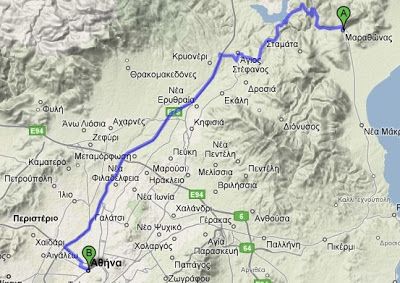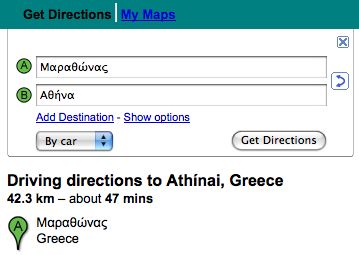The official distance for a marathon is 42.195 km. But why is it so?
Most of the non marathon runners I ask the question answer that this weird number must be due to the conversion from imperial units to the metric system (or the other way round).
It is not. The distance in miles is 26 miles and 385 yards, commonly rounded to 26.2. So why was this distance chosen?
Let’s get back to the origins of the marathon race.
The origin of the marathon
In the year 490 B.C., Miltiade a Greek general from Athens inflicted a serious defeat on the Persians in the plains of Marathon, a small village in the northwest of Athens. In order the convey the news of the victory, a Greek soldier, Phidippides, ran at a stretch from the battlefield to Athens. After delivering the news, he collapsed and died.
What distance did he actually run? We certainly don’t know the exact distance, because we don’t know the route he followed.
I made a little test. I went to the Google maps web site and asked for the direction from Marathon to Athens.With the modern road system, the distance is 42.3 km. Isn’t that amazing? But most historians assume that the distance ran by Phidippides was around 40 km.
Modern marathon
As legendary and fictitious as this story seems, it lead to the creation of the modern marathon race. When Pierre de Coubertin gave birth to the modern Olympic games, the first marathon was set to 40 kilometers. But during the early Olympic games, the distance of the marathon varied a lot. It went from 40 km to 42.75.
| City | Year | Kilometers | Miles |
|---|---|---|---|
| Athens | 1896 | 40 | 24.85 |
| Paris | 1900 | 40.26 | 25.02 |
| St Louis | 1904 | 40 | 24.85 |
| Athens | 1906 | 41.86 | 26.01 |
| London | 1908 | 42.195 | 26.22 |
| Stockholm | 1912 | 40.2 | 24.98 |
| Antwerp | 1920 | 42.75 | 26.56 |
| Paris | 1924 | 42.195 | 26.22 |
The definitive distance for the marathon race was determined in 1921 by the International Amateur Athletic Federation (IAAF). The distance chosen was the one ran in London in 1908 : 26 miles 385 yards or 42.195 km.
The london race in 1908
It is commonly said that the distance was set to 26 miles 385 yards because of the Royal family. During the preparation of the summer Olympiads, it had been agreed that the organizers would include a marathon of about 40 km or 25 miles. The British officials, desirous to accommodate the King of England, started the race at Windsor Castle and finished at the Royal box in the Olympic Stadium—a distance of precisely 26 miles 385 yards.
But that only explains why the London marathon’s distance was 42. 195 km. It doesn’t tell us why this distance was chosen as the definitive marathon distance.
A dramatic event
The London race became famous because of the so called ‘London affair’.
Dorando Pietri, an Italian runner, leading the race was staggering badly when he entered the Olympic Stadium. He collapsed several times on the track. The crowd in the stadium thought he was going to die. A compassionate official, finally helped the semiconscious runner across the finish line. After the event, the story was on the media for days. Some even reported Pietri had died in the hospital after the race. This sensational finish helped the marathon fix itself in the imagination of the crowds as THE endurance race, even though it was dangerous to run. This helped spread the word about marathon running more than anything else.
Unfortunately, because of the help he had received, the Italian runner was disqualified and Johnnie Hayes was declared winner.
The IAAF never officially explained why they had chosen 26 miles and 385 yards as the official distance for the marathon in 1921. But I’m a strong believer that it is due to the enormous emotion generated by the London race.


